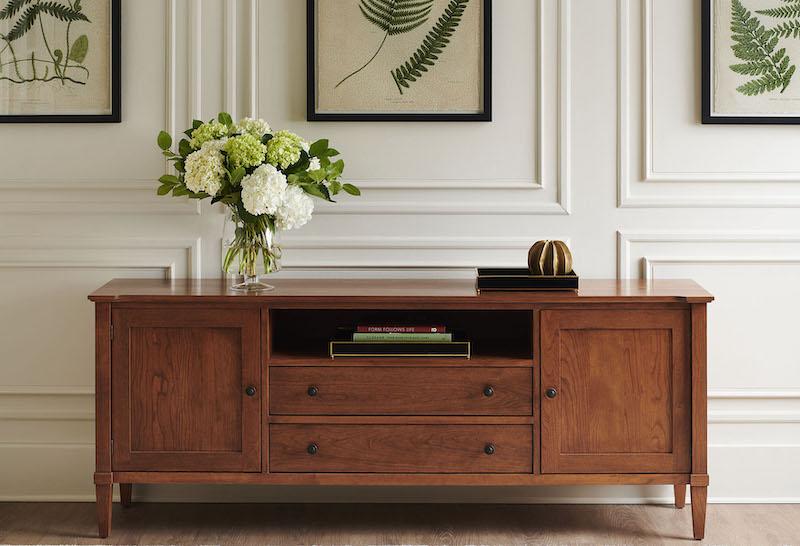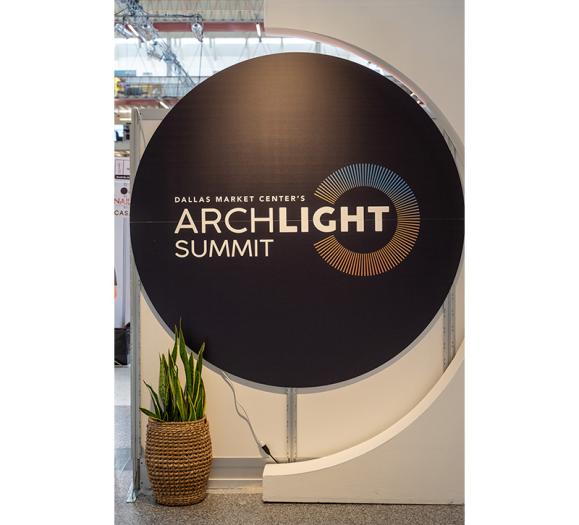Investing in eco-friendly, heirloom quality furnishings is becoming the new norm. Nowadays, homeowners are interested in the sustainability journey, aligning themselves with the missions of companies that fit their personal design needs and standards. They ensure a company’s values match their own, choosing decor that reduces the world’s collective carbon footprint and eliminates waste.
We spoke with a few of the industry’s leaders in sustainability to learn more about their mission and practices.
Made-to-Order
Hubbardton Forge is based in Vermont, a state that cares deeply about the environment. The group designs, engineers, forges, welds, finishes, assembles, packs and ships all from under one roof. In doing so, they successfully create design-driven, handcrafted luxury lighting and decor using environmentally responsible practices.
That ethos began when founders George Chandler and Reed Hampton, two University of Vermont students, met in their senior year in a sculpting class. Both Chandler and Hampton were dedicated to keeping their community safe from pollutants, and found it important to be upstanding corporate citizens. Today, Hubbardton Forge makes each piece to order to keep waste to a minimum.
“We do not order 500 or 1,000 pieces of something and toss them if they don’t get sold,” says Maria Mullen, CEO at Hubbardton. “We take orders one at a time, and make each piece for each individual customer so we are not wasting any materials. We have a great system that allows us to do that in about three weeks, so our customers aren’t waiting. They’re not suffering from poor service because of this zero waste velocity.”
Hubbardton also designs for a client’s life, with the intent that they’ll keep the pieces they order forever. Nothing is made to end up in a landfill.
“The differences that we put into design and quality include a lifetime warranty on our finishes and pieces, and replaceable LED components so you don’t have to toss the entire piece if there is a failure of one LED driver,” Mullen says. “We’re creating an heirloom, not something that gets tossed. It’s not disposable lighting.”
In addition, Hubbardton’s manufacturing processes are cleaner than others. The group does not plate any of its finishes, for example, since it is considered a non-environmentally friendly process.
“It’s not even permitted on a large scale in most of the United States,” Mullen says. “It’s really a dirty process. Instead, we have worked hard to develop shiny finishes using power coating.”
Powder coating is an environmentally friendly process, according to Mullen. It produces low volatile organic compounds (VOCs), and doesn’t produce detritus or other waste. When powder coating metal, however, manufacturers have to ensure it is cleaned efficiently so it adheres correctly.
“We have these amazing large Persico machines that were specially designed to help us clean the metals,” Mullen says. “We have one for aluminum and one for steel. In that process, we are also recycling our wastewater, which is another big thing since water is now becoming more of a crisis and a commodity for people. If we can be more friendly in our manufacturing processes when it comes to water, it helps.”
Hubbardton’s products are also all U.S.-made, keeping its carbon footprint lower than companies who source from overseas. The majority of the component parts the group buys are within the U.S., with a focus on its local Vermont and New England regions.
“Obviously not everything that we need to make lighting is manufactured right here in Vermont — that would be great if it was,” Mullen says. “But we always look local first, and if we can buy it locally we do, whether that is LEDs, glass, leather, metal or slate.”
Sourcing Local
Located in West Virginia, Gat Creek is a family-owned small producer of artisinally crafted furniture. Gat Creek’s Owner, Gat Caperton, a founding member of the Sustainable Furnishings Council, ensures the company selects the best examples of solid cherry, maple and ash wood that the U.S. has to offer. Each piece is handmade in America from solid wood and personally signed by the person who builds it.
Believing that the best furniture comes from the best lumber, the craftspeople at Gat Creek use sustainably harvested wood from Appalachian Forests. Caperton also worked with the Nature Conservancy to better understand his supply chain — where trees were growing, how they’re growing and how they’re being removed.
“I grew up outside Charleston, WV, and for my brother and I, the woods were the ultimate playground,” says Caperton. “When I ended up getting into the solid wood furniture business 26 years ago, I knew I didn’t want to be like the industrious guy that’s cutting all the trees down I played with when I was a kid.”
Since the beginning, Gat Creek has taken a holistic approach to sustainability in its manufacturing, according to Caperton. For the company, it’s about more than just “where does the tree come from?,’” it’s about ensuring it is processed in an eco-friendly manner.
“Our approach starts first and foremost, with the raw materials,” he says. “Second, we’re aware of the amount of energy we use to convert raw materials into finished goods, which is essentially equivalent to how much carbon is put in the atmosphere in the process. Those first two are kind of battling for people’s attention these days. We give weight to both because they’re equally important.”
Caperton also believes using safer, natural materials and choosing solid wood furniture can help avoid bringing toxins into your home. Engineered materials frequently used in furniture manufacturing, especially MDF, have a reputation for leaching VOCs and formaldehyde. Because of this, Gat Creek uses a catalyzed lacquer finish to protect solid wood furniture that is 99.9 percent cured in the production process.
“Ovens and fans in the finishing area, along with time, assure that essentially all VOCs are vacated before the products are delivered to customers,” Caperton says.
Gat Creek also focuses on how to extend the useful life of the product, or the useful life of the product materials without excess energy. Caperton aims to produce a product that can last for multiple generations. When it has lived its full lifespan within one home, it can move to another.
“In our case, it’s really great to have a product that will last generations,” he says. “Our product has some circularity to it, where it can have multiple lives in its current form. We also pride ourselves on our long product lifecycle. Our products capture carbon for a long time so at the end of its life cycle, it’s no more toxic than when it began.”
Recycled Materials
North Carolina-based fabric manufacturer Valdese Weavers also produces decorative, sustainable textiles in the United States for residential and contract markets. The group’s mission is to innovate and produce beautiful textile products that have the lowest impact on the environment in its community.
Valdese Weavers has a large portfolio of sustainable options depending on what aspect of sustainability customers are looking for. Some gravitate toward products made from recycled content,
for example.
“For recycled products, we have several options,” says Christy Almond, VP of Product Development & Marketing at Valdese Weavers. “We have a cotton product made out of recycled t-shirts, so the recycled are the waste in pre-production. They cut off the fabric, take that and turn it into the yarn we weave with. We also have recycled polyester made from post-consumer recycled plastics that we’re able to turn into yarn.”
Valdese Weavers has also recently begun offering product made from Seaqual Initiative’s upcycled marine plastics. Seaqual is a community of individuals, organizations and companies working together to help clean oceans, raise awareness of the issue of marine litter and highlight those helping to fight it. The group partners with global networks of fishermen, community activist groups and community cleanup groups to pick up trash in waterways, or in the ocean.
“The material is then sorted through, upcycled, blended with recycled polyester and turned to yarn,” Almond says. “They also take other materials that can be upcycled and send those out into the world for different uses, and properly dispose of waste that’s floating in the ocean or waterways. They’re not just taking a bottle and diverting it from a landfill, they’re actually working to clean up the environment.”
Valdese Weavers has worked with recycled content for more than two decades, and it is something the group has strongly invested in over the years. Since they have their own yarn-making facility, the group’s weaving, finishing, testing and design and development happens at home base. The vast majority of their raw materials also come from these, with the exception of fibers or some finishing materials.
“This is mainly because material sourcing is important, and in our contract side of our business, recycled content was important for big corporate projects,” Almond says. “We were really expected to partner with the Seaqual Initiative to get that story into our toolbox about four or five years ago, and we finally launched it within the last year and a half. We’re expecting even more this month during October High Point Market, so we’re really excited about that.”







